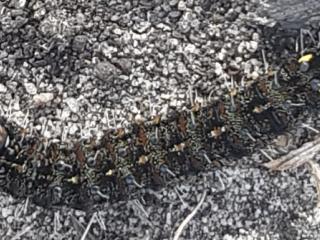Pasture day moth caterpillars
- Busselton
Graham Mussell (Graham Mussell Consulting) reports finding one pasture day moth caterpillar per square metre, in a reseeded pasture paddock south of Busselton. This paddock had a capeweed base before a knockdown spray. The caterpillars are feeding on what is left of the capeweed and as yet have not damaged the emerging sub clover and grass. The paddock will continue to be monitored as although the pasture day moth caterpillars mainly feed on broadleaf species in pasture, they may damage emerging seedling crops when in large numbers and especially when broadleaf weeds are removed with herbicides.
Pasture day moth larvae are dark brown with yellow and reddish orange markings. They have two prominent yellow spots near the end of the body and an orange-black head. Pasture day moth caterpillars remain on plants during the day. The caterpillars grow to about 60mm long before commencing to dig holes in the ground as they get ready to pupate. The moths have brown and yellow patterns on their wings and may be seen flying by day (as the name implies). The insect has only one generation per year.
Pasture day moth caterpillars are not usually considered a pest as they prefer to feed on capeweed, erodium and other broadleaved weeds.
Pasture day moth caterpillars are easily controlled by insecticides.
For more information pasture day moths refer to DPIRD’s Diagnosing pasture day moth damage page.
For more information contact Alan Lord, Technical Officer, South Perth on +61 (0)8 9368 3758 or Dustin Severtson, Development Officer, Northam on +61 (0)8 9690 2160.

